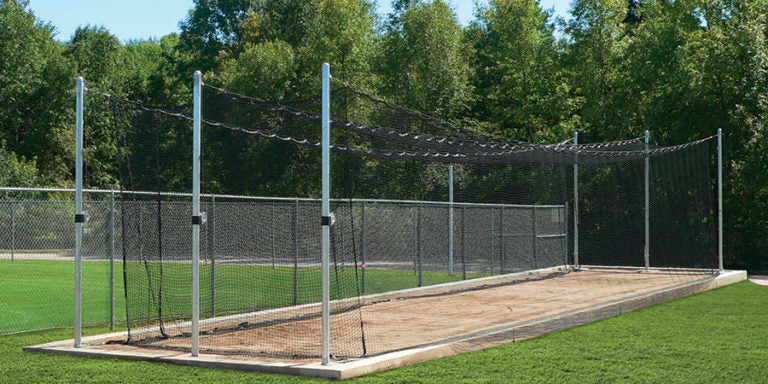Batting Cages: Learn How To Find The Right One!
BEST BATTING CAGE SIZE ?
Length, width, and height are all important elements to review when you’re in the market for a new cage. If you plan on using it at home in your backyard, odds are you don’t want a cage that’s going to take up the majority of that space. If you have room for a larger size, then you’ll definitely want to utilize it and go with a bigger size for maximum efficiency when stepping up to the in-cage plate.

HOW TO PICK CAGE LENGTH
As stated earlier, batting cages come in many shapes and sizes to suit almost anybody’s needs. The length of the unit is crucial to measure a batter’s performance. The optimal batting cage length is 70 feet. This allows ample space between the pitcher–or pitching machine–and the batter. It also allows greater accuracy in tracking the ball's velocity of hits. If you don’t have a yard large enough to fit a full-sized cage, no worries. Cages come in lengths as little as 20-feet, which can still provide a beneficial experience when practicing.

Don’t want to commit to a regulation-sized batting cage length? No worries. Though the regulation length is great for practicing since it creates a realistic scenario, not everyone has room for a 70-foot batting cage in their yard. Shorter cages are not only great for saving space and money; they can even improve a batter’s reaction time. Since the distance between the pitcher and the batter is shortened, the batter will need to react quicker. This will translate to a regulation setting well as the batter will then be able to use their skill advancements to react quicker to pitches. A shorter cage can also aid a batter’s accuracy by forcing them to act quickly and swing more precisely to make contact with the ball.
BATTING CAGE LENGTH RECOMMENDATIONS BASED ON AGE AND SKILL
T-ball: 38’ to 44’
Little League: 48’ to 55’
High School: 60’ and up
College: 70’ and up
Again, if your yard isn’t big enough to accommodate to these recommendations, don’t worry. Practicing your swing in a 20’ cage is better than not practicing at all!
HOW TO PICK BATTING CAGE WIDTH
The standard width for batting cages is around 12 to 14 feet. Younger players who are still developing their skills will find sufficiency in 12-foot wide tunnels. Bigger and more advanced players will be better off with a 14-foot wide tunnel. Width also varies from player to player depending on wingspan, so if you or your batter have longer arms, consider a wider cage.
SELECTING THE RIGHT BATTING CAGE HEIGHT
Most players will find a 12-foot high batting cage to be sufficient for their needs. Just like longer cages provide optimal room for tracking ball velocity off of hits, so does a greater height. If 12 feet is a bit more than you can handle, an 8-foot tall batting cage frame should work just fine. Another consideration is that the height of the frame also depends on which netting you plan to use for your cage. You will want to be sure that there is enough room for batting cage netting overflow, about one foot of extra netting to sag on the ground. This will help contain balls as they fly around the cage.
WHAT MATERIAL IS BEST FOR A BACKYARD BATTING CAGE?
Choosing the right batting cage frame doesn’t end at batting cage size – the material used in the frame’s construction is just as important. There are three primary materials used to make up a batting cage: Fiberglass, Fiberglass with Steel Rods, and Full Steel. Each type has its advantages and disadvantages. Fiberglass, for example, can shatter from the impact of a direct hit fast-traveling ball due to a powerful hit. On the other hand, Full Steel frames will hold true to their original form against the hardest of hits and can withstand harsh weather conditions, such as high winds. Let’s take a deeper look into what each material brings to the table:

FIBERGLASS
Fiberglass is the least expensive option of the three material types. The lower-priced batting cages are typically made up of a fiberglass construction and frequently won’t be regulation size, but this isn’t always the case. Frames made from fiberglass material, particularly the rods or poles, can shatter from the impact of hard-hit balls. This is why it’s considered one of the “cheap” options, though it’s a great choice for younger players who are working on developing their eye-hand coordination and swing power. The starting price for cages made with a fiberglass structure is about $100 but can range up to $1,000 depending on its size and other features. fiberglass construction is not commonly used in models more expensive than a few hundred dollars.
Who it’s best for:
- Smaller, younger players who are starting to advance their skills and don’t hit the ball with a great amount of power.
FIBERGLASS WITH STEEL RODS
The perfect balance between quality and affordability. The upright poles, called rods, are made from steel. This provides a highly durable support structure that can handle direct ball hits from heavy hitters. The framing surrounding the ceiling is made from fiberglass, which offers a discounted price from the full steel construction option. With a higher level of durability and a longer lifespan than an all-fiberglass construction, the hybrid design will run a price range starting at about $300 and up to as high as $1,000.
Who it’s best for:
- Though it can be used by most ages, sizes, and skill levels, a fiberglass frame with steel rods is best for developing players between Little League and high school who can hit the ball with moderate power.
FULL STEEL
The most durable and toughest design by far is the full steel construction. Both the framing and the rods are completely made up of steel. This makes it super tough and allows it to stay intact against the hardest hit balls. Because of the increased durability, greater sturdiness, and longer-lasting life, it is the most sensible investment if you can afford the higher price tag. Considering other variables at play, the cost of a full steel construction ranges from as little as a few hundred dollars to as high as $2,000, but it’s well worth the investment you make.
Who it’s best for:
- High caliber players who are developed and can put a lot of power into each hit. Usually, high school level and higher, though the durability and reliability of full steel construction can’t beaten.
HOW TO PICK THE RIGHT BATTING CAGE NET
Selecting the correct size of frame for your batting cage is one thing; the netting you choose to put over the top of the frame is another important aspect. There are a few considerations here. One, the cost of a net is telling of its quality. This is a standard truth among the batting cage netting industry. Two, there are multiple styles of netting for different types of activities and requirements. Choosing a style in line with your needs is critical to its efficiency. Third, the type of net twine used determines the durability of the netting, the effectiveness of its intended purpose, and the diameter of the meshing that makes up the net itself. Nets come in all shapes and sizes, so which one is best for you?
BATTING CAGE NET COST AND QUALITY
The phrase, “what you pay for is what you get," directly applies to baseball nets. Low-priced nets, whether new or used, will most likely come with low quality. This doesn’t mean that nets can’t be both good quality and affordable, though. A good practice is to weigh your options by researching different manufacturers and distributors and consider how their nets are made and what type of material they’re made with.
NET STYLES
BARRIER/CONTAINMENT NETS
This primary style of netting is exactly as its name suggests; it provides a barrier that contains balls so they don’t fly out and affect surrounding buildings or objects. Commonly used in baseball facilities, golf courses, and backyards, these nets are popular across many sports. Barrier nets consist of four walls–two sides and two ends–and a ceiling and sit overtop of the cage like a fitted blanket.
The size of the net chosen is completely dependent on the length, width, and height of the cage’s frame, so make sure to know the specifications of your chosen frame before going all in on a net.
They also offer a great opportunity for batters to practice their hand-eye coordination, as the pitcher has to be within the length of the cage’s parameters and will determine the accuracy of ball flight tracking if designed properly. Be sure the netting you select has a proper mesh diameter to prevent balls from slipping through and escaping the cage’s interior.
BATTING CAGE NET TYPES
Once you’ve decided which style of net you need, there are a few different things to consider: durability, mesh diameter, and lifespan. The net twine will determine each of these elements. Net twine is measured in numbers, with smaller numbers meaning a smaller diameter in the mesh construction of the netting. Along with mesh diameter, the higher the number, the more durable the netting will be. Its durability will determine the conditions it can survive, both weather and wear and tear from usage, as well as the lifespan of the net. Lastly, higher numbers reflect better quality, which in turn will drive the price. Here are the four most common types of net twine:

#21 NETTING
This netting can survive in most weather conditions and is durable enough to hold its own against a fair number of hits. It’s recommended for light home use or young stars just learning the ropes of batting. The thin net and small mesh diameter make it ideal for moderate use by the youngest players and will last approximately 3-4 years.
#30 NETTING
A tougher net than the #21 netting that offers a greater mesh diameter to withstand harder hits by bigger players. This type is recommended for Little League players who have the fundamentals down and are transitioning into a stage of skill advancement. It provides greater durability and can stand up to harsher winds and cold weather. The lifespan is approximately 4-5 years.
#36 NETTING
A great middle-ground net twine that can be used by most ages and player levels, though mostly recommended for high-school level players. It’s tough, has a large mesh diameter, and will survive most weather situations. Its thick net also extends its lifespan, which is approximately 4-5 years.
#42 NETTING
The holy grail of batting cage netting is the #42 net twine. This is the strongest, thickest, largest, and most durable netting of all the options listed. It can survive nearly any weather conditions thrown at it and will withstand many hits from the hardest hitters. The larger gauge of mesh diameter gives it long-lasting use, with its lifespan being 5+ years.
HOW MUCH DOES A GOOD BATTING CAGE COST?
A good batting cage can cost anywhere between $200 and $10,000.
For smaller backyard batting cages, the average cost is around $1,000 - and usually, you can find a good one for that price. And for outdoor commercial batting, cages cost upward of $5,000.
Residential batting cages are usually designed for younger players and will see less usage than a full-sized commercial batting cage.


